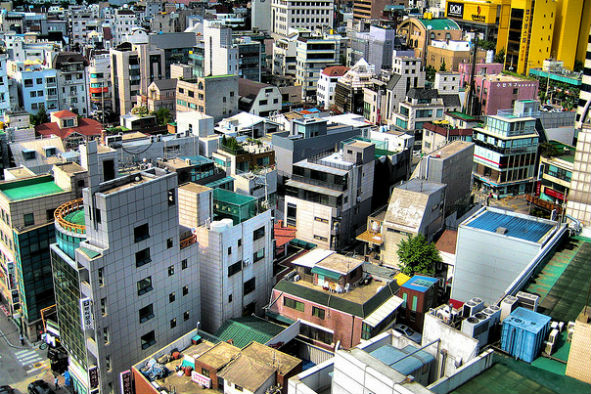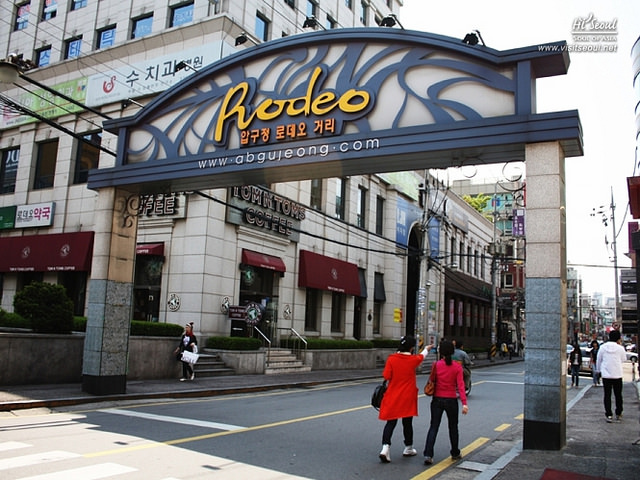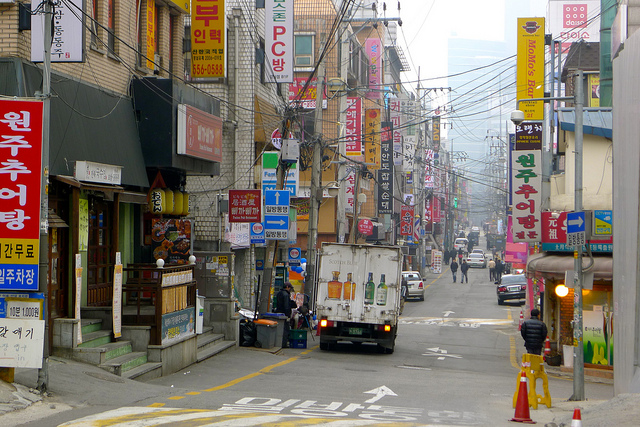Almost everyone has done the dance at one time or another, but where is Gangnam, and what is it about this place that inspired the most watched music video of all time? A walk around the neighbourhood helps unlock the secrets not only to this question, but also to the Korean soul.

Gangnam (Photo: F. Anzola via Flickr)
Climbing up the side of the building was a 20-foot gorilla. Beneath him was a giant severed hand pointing an accusatory index finger at the sky. If the gorilla fell, it would have wound up being the world’s most bizarre prostate exam. It almost looked as though this fake King Kong was trying to escape the finger. The luminous yellow North Face rucksack on his back and the lack of a damsel in distress gave him the air of a tourist in the midst of being chased by angry locals, rather than the terrifying beast, King Kong.
I had come across this absurd pageant of gorilla and hand whilst wandering around Seoul’s hip Gangnam region. What I had largely experienced was an odd balance of mimicry and originality in the art and fashion of the region that, combined together as one, was at times confusing, other times frustrating, but always compelling.
South Korea’s vibrant capital city is cleaved apart by the Han Gang, or Han River, which runs from east to west. The north, or ‘Buk’, side of the river is where most of Seoul’s historic buildings can be found. The south, or ‘Nam’, side of the river is comparatively much newer, and this modernity means it is well developed, albeit slightly monotonous. The South side of the River is where Korea’s financial centre, and much of its wealth can be found. Gangnam is the most up-market borough on this side of the river, and I was exploring on foot.
I had begun my walk in Apgujeong, the northern neighbourhood of Gangnam. It has a street called Rodeo Drive – a signal of the source of Korea’s biggest creative influence. Apgujeong makes the bulk of its wealth it seems from altering appearances. It is this side of Gangnam, and indeed Korea, that Psy is really talking about in his infamous song Gangnam Style.
Like it or not, the official Youtube video has reached more than 2 billion hits. It has been reposted hundreds of times on other accounts, gaining another couple of hundred million views. So by my reckoning, 33-40% of all people in the world have seen the video. To give you a sense of magnitude, there are an estimated 2.1 billion Christians worldwide. It is highly likely that more people have seen Gangnam Style than have been to church.
The motif of the song is that Gangnam is the haven of the vacuous and shallow individual, who is concerned more with outward appearances, rather than inner qualities. It is done in such a tongue-in-cheek way that few recognise this, but the interesting irony is that the simplicity he mocks was ultimately what made the song, and Psy himself, so popular. I wanted to understand whether this point of view had any validity.

Rodeo Street in Apgujeong, Seoul. (Photo: Visit Seoul via Flickr)
Keeping up Appearances
Everybody in Korea is well dressed. The wide spectrum of fashion is not represented in Korea because fashion is less about making a statement of personality or belief, and more about pride of personal presentation in public. Even at Korea’s universities, students seem well presented. When I was at university, most of us had torn clothes, messy hair and perma-hangovers before the first week was even over.
Plastic surgery is a huge business in Korea. Apgujeong is its nerve centre, with people travelling from all over the world to go under the knife. The eyelid fix is one of the most common operations that a majority of Korean girls receive. My friend SoYeong had the operation when she was 16.
“They cut the eyelid so that it looks like a double eyelid. It is more western looking.” SoYeong said.
She pointed out a woman who had not had the operation done, and I notice the single eyelid she talks of for the first time. Had she not pointed that out to me as being seen as inferior in terms of eyelid genetics, I would never have thought anything of it.
“My parents paid for the surgery as a graduation present from high school,” said SoYeong.
Clusters of surgeries were dotted across various floors of high rise buildings. One was called Small Faces. It would seem that large faces are not in vogue. Another was offering to undertake six-pack plastic surgery. This idea appealed to me. I was becoming tired of constantly watching what I ate and doing hundreds of sit-ups a day, so I put in a call to Dr. Kim to ask about getting me sorted out permanently. The receptionist told me that they could only operate on Asians, not Westerners. I put the gym card I was about to ceremoniously burn back into my wallet.
Dedicated Followers of Fashion
I walked past The Galleria, one of the huge shopping malls in Gangnam. The most impressive is further south in the Gangnam borough called the COEX mall, but I had a more tangible connection with The Galleria.
Having worked in Korea as a filmmaker, I found that I was primarily hired as an actor instead. On one occasion, a particularly shady talent agent sent me on a job for one of the shops at the mall. She told me very little in terms of details. It turned out to be the opening of a new clothing shop with an American theme. On arrival I spent ten minutes in the bathroom, my agent trying to cram thick insoles inside ill-fitting cowboy boots, so that I would appear to be as tall as she had told the shop owner I was.
The rest of my day was spent trying to coax, or at the very least confuse, Korean shoppers into the store with my absurd imitation of an American accent, which sounded more like a cross between Clint Eastwood and Bugs Bunny than an actual human.
I looked up at the mall’s facade, crafted from mother-of-pearl glass discs like layers of hubcaps. I had no desire to go inside, for fear that I would be roped once again into an outlandish marketing scheme, or caught out for not actually being 5ft 11 inches tall.
It was here that I met up with Evan, a Seoulite who runs a website called Fashion in Korea. He, like everybody else, was well dressed and wearing a smart shirt. I suddenly felt inferior in my rugby shirt and worn jeans.
We went for a walk. I was interested in what he thought about the accusations against the imitative, or at times even plagiaristic nature of Gangnam’s style.
“It’s a mixture between old Korean and Western these days” he said. “But Korea’s own spiritual heritage is mixed into everything.”
I asked him what he thought about Psy and the image of Gangnam that was espoused to the world in his video, even if it was a playful one.
“I think the song describes an old stereotype of Korean fashion,” he said.
“So then, do you think the video encouraged creative Koreans to be more personalised in their style?” I asked.
“When you look more deeply at the style here, you could always see the originality and unique styles growing up,” said Evan. “Yes, you can look at one area of Korean life like the plastic surgery, but just viewing that is just a one-way image of Gangnam. You could look at one area of fashion in England or France and see that their style is just copied from America too.”
We wandered along streets lined with flashy stores selling the latest styles. Occasionally an oblique facade threw architectural courage in among the general monotony of Seoul’s skyline. However, much of Gangnam’s spirit was far more subtle: here and there, little galleries were tucked away down back streets, or an independent coffee shop opened onto the streets, filled with little objects made by hand, and creative murals on the wall. Hidden inside uniform buildings with bland exteriors, the signs of creative endeavour were everywhere.

Gangnam Back Street (Photo: (Antonio Viva via Flickr)
“Many artists and fashion designers here are inspired by all sorts of other creative people. They’re inspired by artists, by music, even by magicians,” said Evan, “some fashion designers say their new products are inspired by musical beats or sounds. They use a beat they like and channel it when drawing their own designs.”
I was beginning to understand what he meant. There was something unmistakably Korean in the art and fashion I was witnessing. What I had mistaken for a lack of personality was really a sense of pride. Korea had been under the yolk of Japanese rule for centuries, only to be broken in half by civil war. It is only natural that America was like a big brother, as South Korea was guided to independence. Now Korea is at the top of its game in areas like cars and electronics. Companies like LG, Hyundai and Samsung give reason for national pride and that is being expressed ever more in Korea creativity.
As I bade farewell to Evan, I decided to keep wandering through the tight streets of Gangnam. I had acquired a new found respect for the work Korean’s were doing in Gangnam to enhance a sense of Korean identity, and personality, through their work, one stitch or brush stroke at a time. Then I came across the severed hand and the 20-foot gorilla, and realised that creativity and style cannot be categorized so simply. When done right, it will always have the capacity to surprise.